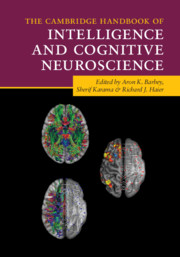Book contents
- The Cambridge Handbook of Intelligence and Cognitive Neuroscience
- Reviews
- The Cambridge Handbook of Intelligence and Cognitive Neuroscience
- Copyright page
- Dedication
- Contents
- Figures
- Tables
- Contributors
- Preface
- Part I Fundamental Issues
- Part II Theories, Models, and Hypotheses
- 5 Evaluating the Weight of the Evidence
- 6 Human Intelligence and Network Neuroscience
- 7 It’s about Time
- 8 A Lifespan Perspective on the Cognitive Neuroscience of Intelligence
- 9 Predictive Intelligence for Learning and Optimization
- Part III Neuroimaging Methods and Findings
- Part IV Predictive Modeling Approaches
- Part V Translating Research on the Neuroscience of Intelligence into Action
- Index
- References
6 - Human Intelligence and Network Neuroscience
from Part II - Theories, Models, and Hypotheses
Published online by Cambridge University Press: 11 June 2021
- The Cambridge Handbook of Intelligence and Cognitive Neuroscience
- Reviews
- The Cambridge Handbook of Intelligence and Cognitive Neuroscience
- Copyright page
- Dedication
- Contents
- Figures
- Tables
- Contributors
- Preface
- Part I Fundamental Issues
- Part II Theories, Models, and Hypotheses
- 5 Evaluating the Weight of the Evidence
- 6 Human Intelligence and Network Neuroscience
- 7 It’s about Time
- 8 A Lifespan Perspective on the Cognitive Neuroscience of Intelligence
- 9 Predictive Intelligence for Learning and Optimization
- Part III Neuroimaging Methods and Findings
- Part IV Predictive Modeling Approaches
- Part V Translating Research on the Neuroscience of Intelligence into Action
- Index
- References
Summary
Flexibility is central to human intelligence and is made possible by the brain’s remarkable capacity to reconfigure itself – to continually update prior knowledge on the basis of new information and to actively generate internal predictions that guide adaptive behavior and decision making. Rather than lying dormant until stimulated, contemporary research conceives of the brain as a dynamic and active inference generator that anticipates incoming sensory inputs, forming hypotheses about that world that can be tested against sensory signals that arrive in the brain (Clark, 2013; Friston, 2010). Plasticity is therefore critical for the emergence of human intelligence, providing a powerful mechanism for updating prior beliefs, generating dynamic predictions about the world, and adapting in response to ongoing changes in the environment (Barbey, 2018). This perspective provides a catalyst for contemporary research on human intelligence, breaking away from the classic view that general intelligence (g) originates from individual differences in a fixed set of cortical regions or a singular brain network (for reviews, see Haier, 2017; Posner & Barbey, 2020).
- Type
- Chapter
- Information
- Publisher: Cambridge University PressPrint publication year: 2021



